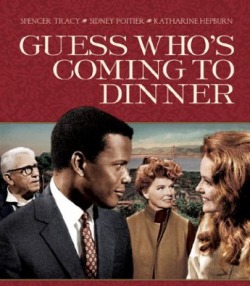
Guess Who's Coming to Dinner, 1967
What would you say was the 'social context' for the film?
The social context of this film is quite unusual as at that time African Americans would not normally be seen playing a middle class doctor. The film appears to be set in a White, middle class enviroment in which a young, White woman brings an African American doctor home to meet her parents. When she talks about him to her mother she talks about how much she loves his name (John Wade Prentice) and can't wait to marry him, showind she has no prejuidice and become Jonna Prentice. When she says this to her mother no one knows yet the race of the man because his name is not stereotypically African. When she discovers he is African American she is in shock.
Is this 'social context' trapped historically?
When hearing his name is John Wade Prentice, because African Americans had their slave masters names historically, her mothers reaction was initally good and she accepts this man before she even met him. However, the mother reveals her prejudice towards him, when she reacts in shock when seeing him, but he seems to expect that sort of reaction from her and sort of got used to it. This seems to go back to the 'Good Negro' stereotype of African Americans, who remain submissive, generous and kind no matter how racist people are towards them.
How does SHEP affect the representation of African Americans in this film trailer?
The African Americans characters job as a doctor was not really representive of African Americans at that time, but that could be for a number of reasons, as African Americans would probably not have had the same educational oppurtunities as others to become doctors. However it is good stereotype for an African American to see him playing a doctor, formally dressed, middle class and respectable.
The man playing the doctor is Sydney Poitier, who was a very famous African American actor at the time, he was an Academy Award winner and in the trailer for the film he has second billing, giving us an idea of the ideology of the institution involved in representing African Americans as equal to White people. This can be seen in the voice over in trailer, 'three award winners and a newcomer' (refering to the young white actress), but it could also be interpreted as appearing 'Colour Blind' towards African Americans as his race is not even acknowledge, showing that the institution does not have prejudical attitudes towards race but not a positive one either. The audience of the film would be multi-racial and of different ages.
Write a short paragraph exploring the issues of Social Context.
The social context is the identical or similar social positions and social roles as a whole that influence the individuals of a group. The social enviroment of an individual is the culture that he or she was educated and/or lives in, and the people and institutions with whom the person interacts.
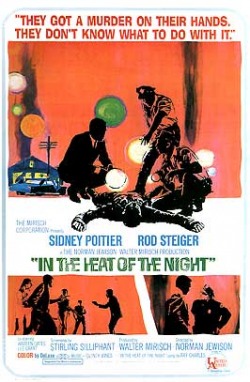
In The Heat of the Night (1967)
How are African Americans represented in this film?
The film seems to have an underlying hint of comedy throughout the extract which can be clearly seen when it is discovered the African American man they arrested on suspicion of killing someone, only because the man is Black but he actually turns out to be a police officer himself!
The White police officer wrongly accuses him of doing something wrong, mainly beacause he's a Black man and when being arrested refers to him as 'boy' intending to belittle him. This was also how, during the period of Slavery, all Black man were refered to as 'boy' by their masters as a way of maintaining their status and power. From this we can tell how racist a character the police man is because while hand cuffing him he also steals his wallet. He is then treated roughly and taken to the police station as if he were a criminal despite doing nothing wrong. The African American man appears smartly dressed and though he is called 'prisioner' and the his name is made fun of he continues to be well spoken, respectful and stands his ground in terms of defending himself. The police cheif after seeing him immediately assumes that he must have beaten a police officer without even questioning him.
However towards the end of the extract we learn that he is a police officer himself and is better paid, better dressed and more professional then his White counterpart. This shows pinch of irony that can be seen through the African American man actually being a police officer and getting arrested. This film is good in the sense that it plays on the typical African American sterotype and turns it on its head.
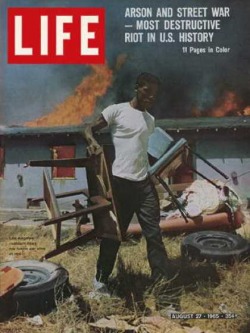
Life Magazine Cover, Watts Riot, 1968
The Watts Riot occured in LA and was sparked by the beating to death of Rodney King, an average African American male who was targeted just because he was Black. 3,000 African Americans were arrested during the riot and abanded jails had to be opened to accomadate them. A curfew was put in place for the people of Watts and was off limits for everyone else. In a news report, Watts, where mainly African Americans reside, was portrayed as a war zone with soliders patrolling the area, snipers targeting people with the use of dramatic music.
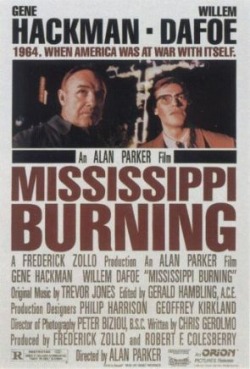
Mississipi Burning, 1968
How are African Americans represented in this film?
The basic plot of the film is loosely based on the murder of three civil rights workers. The Heros of the film were White American men one of whom is a man from the North of America with what would be considered contemporary views of a man about African Americans, while the other White man is a Southern Man who has quite Racist views about Black people. The Villians of the film are the KKK who wanted to wipe out the Black Race and anyone else who was not a fully White Christian and despite the African Americans being the victims within the films storyline, they are exploited, abused, powerless and appear as minor character in their own drama.
The 1960's in the US was a time of great change. Can it be argued that Hollywood was leading that change?
It could be argued that Hollywood expressed changing views that inspired a shift to take place throughout society. This could be seen by Sydney Poitier's major roles in 'Guess Who's Coming to Dinner' and 'In the Heat of the Night' where he plays professional characters and he is advertised in trailers as a star and an Oscar winner. It could be said that doing this could be reinforcing the idea at the time where civil rights was difficult.
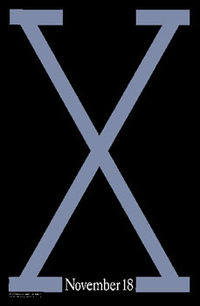
Malcolm X, 1992
What point is Spike Lee trying to make in the opening of Malcolm X?
Malcolm X is a biographical film about the African American activist and Black nationalist Malcom X, directed by Spike Lee. The film came out in the 90's but was set in the 1960's however real footage from the attack that killed Rodney Jenkins was used, which only happened a year before the fillm was released. This link is crucial because it means to make a link to the audience and inform people that nothing has changed and violence and racism is still strong. Rodney Jenkins death also sparked a major riot in L.A, a year later.